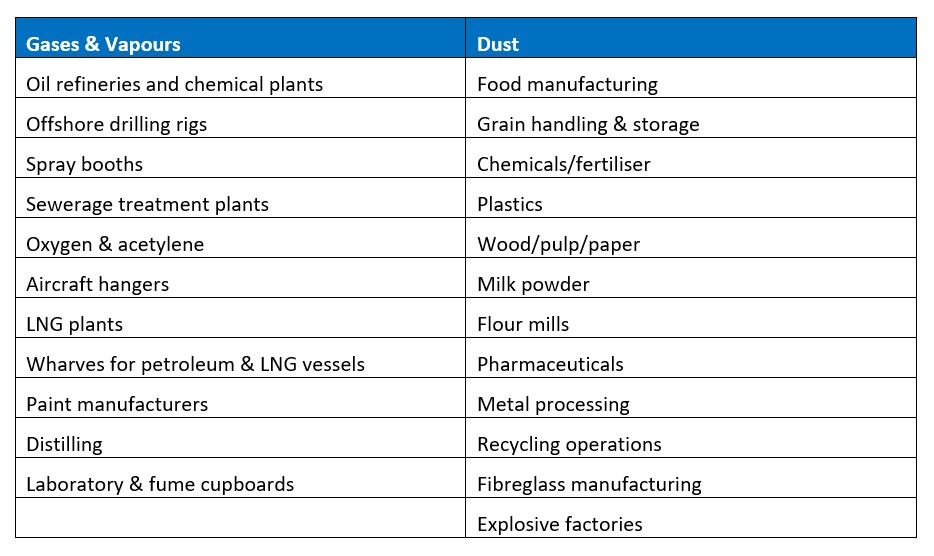Things about Roar Solutions
Things about Roar Solutions
Blog Article
8 Easy Facts About Roar Solutions Explained
Table of ContentsNot known Incorrect Statements About Roar Solutions Excitement About Roar SolutionsThe smart Trick of Roar Solutions That Nobody is Talking About
In such an ambience a fire or explosion is possible when three fundamental problems are fulfilled. This is often described as the "dangerous area" or "burning" triangle. In order to safeguard setups from a potential explosion a technique of evaluating and categorizing a possibly dangerous area is required. The purpose of this is to guarantee the appropriate choice and setup of equipment to eventually prevent a surge and to make sure safety of life.
(https://au.pinterest.com/pin/1124703706941720474)
No tools should be installed where the surface temperature of the equipment is higher than the ignition temperature of the provided risk. Below are some common dust hazardous and their minimum ignition temperature. Coal Dirt 380C 225C Polythene 420C (thaws) Methyl Cellulose 420C 320C Starch 460C 435C Flour 490C 340C Sugar 490C 460C Grain Dirt 510C 300C Phenolic Material 530C > 450C Aluminium 590C > 450C PVC 700C > 450C Soot 810C 570C The possibility of the risk existing in a concentration high adequate to create an ignition will certainly differ from place to location.
In order to categorize this risk a setup is divided right into areas of risk relying on the quantity of time the dangerous is present. These locations are described as Areas. For gases and vapours and dusts and fibers there are three areas. Zone 0 Area 20 An unsafe ambience is extremely likely to be existing and may exist for extended periods of time (> 1000 hours per year) or perhaps continually Zone 1 Area 21 An unsafe ambience is possible yet unlikely to be present for lengthy periods of time (> 10 450 C [842 F] A category of T6 indicates the minimum ignition temperature level is > 85 C [185 F] Harmful area electric equipment possibly developed for usage in higher ambient temperature levels. This would showed on the score plate e.g. EExe II C T3 Ta + 60C( This means at 60C ambient T3 will certainly not be exceeded) T1 T1, T2, T3, T4, T5, T6 T2 T2, T3, T4, T5, T6 T3 T3, T4, T5, T6 T4 T4, T5, T6 T5 T5, T6 T6 T6 A T Course score of T1 means the maximum surface area temperature level generated by the tool at 40 C is 450 C. Assuming the connected T Class and Temperature level score for the tools are suitable for the area, you can constantly utilize a tool with a more rigid Division score than needed for the area. There isn't a clear answer to this concern. It actually does depend on the type of tools and what repairs need to be lugged out. Equipment with certain examination procedures that can't be done in the area in order to achieve/maintain 3rd party score. Have to come back to the factory if it is before the tools's solution. Area Repair Work By Authorised Worker: Difficult testing may not be called for nonetheless particular treatments may need to be complied with in order for the devices to keep its 3rd event rating. Authorised workers need to be employed to execute the job correctly Repair work need to be a like for like substitute. New element need to be taken into consideration as a straight substitute calling for no unique screening of the tools after the repair is complete. Each piece of equipment with a dangerous score ought to be assessed separately. These are described at a high level below, but for more detailed details, please refer straight to the standards.
Fascination About Roar Solutions
The tools register is an extensive data source of equipment documents that includes a minimum set of areas to identify each thing's location, technological specifications, Ex-spouse classification, age, and ecological information. This info is crucial for monitoring and managing the devices properly within dangerous locations. On the other hand, for regular or RBI tasting inspections, the grade will certainly be a combination of In-depth and Close examinations. The ratio of In-depth to Shut evaluations will be established by the Equipment Danger, which is examined based upon ignition threat (the possibility of a resource of ignition versus the chance of a flammable atmosphere )and the harmful location category
( Area 0, 1, or 2). This variation will likewise influence the resourcing demands for job preparation. When Great deals are specified, you can develop sampling strategies based upon the sample dimension of each Great deal, which refers to the number of random equipment items to be evaluated. To identify the called for sample size, two facets need to be examined: the size of the Whole lot and the category of evaluation, which suggests the level of initiative that need to be applied( reduced, regular, or increased )to the assessment of the Whole lot. By combining the category of evaluation with the Whole lot dimension, you can after that establish the ideal being rejected requirements for an example, indicating the allowed variety of faulty things discovered within that example. For even more information on this procedure, please describe the Power Institute Guidelines. The IEC 60079 conventional advises that the maximum interval in between evaluations need to not go beyond three years. EEHA evaluations will additionally be carried out outside of RBI campaigns as part of scheduled upkeep and devices overhauls or fixings. These examinations can be attributed toward the RBI example sizes within the affected Great deals. EEHA evaluations are conducted to determine faults in electric equipment. A weighted racking up system is vital, as a solitary piece of tools may have numerous mistakes, each with varying levels of ignition risk. If the consolidated rating of both inspections is less than twice the fault rating, the Whole lot is considered acceptable. If the Lot is still thought about undesirable, it has to go through a full assessment or justification, which may set off more stringent inspection protocols. Accepted Lot: The root causes of any kind of mistakes are determined. If a typical failure setting is located, extra equipment may call for inspection and fixing. Mistakes are categorized by intensity( Safety, Integrity, Home cleaning ), making certain that urgent issues are examined and addressed promptly to minimize any effect on safety and security or operations. The EEHA database ought to track and tape the lifecycle of mistakes in addition to the corrective actions taken. Executing a durable Risk-Based Inspection( RBI )technique is vital for ensuring compliance and safety in managing Electrical Equipment in Hazardous Areas( EEHA) (high voltage courses). Automated Fault Rating and Lifecycle Monitoring: Easily take care of mistakes and track their lifecycle to boost examination precision. The intro of this support for risk-based evaluation even more enhances Inspectivity's setting as a best-in-class service for regulatory compliance, along with for any kind of asset-centric examination use situation. If you have an interest in finding out more, we invite you to request a presentation and discover how our remedy can change your EEHA administration processes.
The Best Strategy To Use For Roar Solutions

In terms of explosive danger, an unsafe location is a setting in which an eruptive environment exists (or may be expected to be present) in quantities that require unique safety measures for the building, installation and use tools. high voltage courses. In this write-up we explore the difficulties faced in the workplace, the risk control procedures, and the required expertises to work securely
These materials can, in specific problems, form explosive ambiences and these can have major and awful effects. Many of us are acquainted with the fire triangle get rid of any type of one of the 3 components and the fire can not happen, but what does this mean in the context of hazardous locations?
In many instances, we can do little about the levels of oxygen airborne, yet we can have significant influence on sources of ignition, as an example electric tools. Dangerous locations are documented on the harmful location classification illustration and are identified on-site by the triangular "EX-SPOUSE" sign. Below, amongst other essential details, areas are split into 3 types relying on the threat, the chance and duration that an eruptive environment will exist; Area 0 or 20 is regarded one of the most harmful and Zone 2 or 22 is considered the least.
Report this page